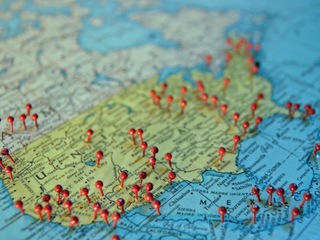With the rise of customer experience as a corporate function, customer journey mapping is taking its place as a vital component of any program or process focused on enhancing customer centricity. Here are a few insights on how to get the most value out of your customer journey mapping efforts.
1. Customer Journey Mapping: Be clear what experience you’re mapping and why
Some companies invest a lot of time and money creating immersive, life-size dioramas depicting their customer’s experience with touchpoints in all forms. Some take a simpler, chart-like approach to mapping out the customer’s flow of communications and interactions. Regardless of the scale, the question remains — why?
Other companies use customer journey mapping to get a bird’s-eye view of what’s actually going out to customers, because the siloed structure of the organization obscures the total picture. That’s a good reason. For still others, the primary purpose is to rally senior executives who might be a little too removed from the customer experience by getting them to walk in the customer’s shoes. Also excellent. We once developed a program for a bank after the chairman’s wife had her purse stolen and lived through the hassle first-hand, so we don’t discount the value of this exercise unto itself.
But then what? Too many companies seem to get stuck at this point. Understanding what you’re currently doing is really only valuable if it imparts wisdom about how to do it better — what to keep doing, stop doing or start doing. The next step of effective journey mapping is to take a cold, hard look at how well the current experience is working.
2. Invest in customer research to identify true needs, actual behaviors, and real hits or misses in usability
The best way to understand what customers want is to ask them: What drives them to select one product or service over others? Which touchpoints are most important to them (and therefore have the greatest potential to influence their brand experience)? When and how do they prefer to receive information?
The best way to know what customers are doing is to watch them. We’re all pretty unreliable in describing what we do, so ethnographic research is the unfiltered way to see how customers are actually interacting with products or services. And usability testing or task-based comprehension testing is the key to measuring the customer’s true ease of use and accuracy of understanding.
There are a variety of qualitative and quantitative methods that may apply based on the type of customer journey you wish to evaluate — any of which will help you get to the heart of how customers truly think, feel and behave. Armed with the insights derived from customer research, you can …
3. Overlay the research results with the current experience map
When you compare those true customer insights to the related customer journey map, you suddenly see where it’s a good fit … and where it’s not. This will show the gaps between the business-centric view and the customer-centric approach. This layered view will help you set priorities, validate or refute internal opinions, and mediate conflicting agendas across business units. After all, the customer is always right!
Determining how to reconfigure the current customer experience to better meet customer needs is an essential step in the customer journey mapping process, but you’re not home free yet…
4. Be realistic about organizational commitment to transformation
An organizational reality in some companies is that Customer Experience (big “C” and “E,” for the corporate functional area) has the responsibility to transform the customer experience, but not necessarily the mandate, authority or budget to do it. Moving toward a truly customer-centric approach requires commitments that span the whole enterprise and almost always include the following common denominators:
Truly simple, customer-focused products and services. It’s the old lipstick-on-a-pig phenomena if you’re trying to map out a customer-centric experience around complex offerings.
A customer cloud. If you can’t personalize information based on what you know about the customer — especially a valuable customer who has multiple accounts or has bought add-on services — you’ll never get all the way to the ideal customer journey. While customer data will continue to come from myriad sources, a customer cloud will facilitate centralized data collection and analytics.
Disclosure that is truly commensurate with risk or exposure. Engage compliance (and even the regulators directly) early and often in the process. You might be surprised at how cooperative they are when they see you’re working hard to meet the true spirit of disclosure, not just the letter of the law.
Decision making at the right level with the right information. It goes back to that responsibility versus authority thing. When change requires cooperation across business units and budgets, it’s essential to have clearly defined roles for decision making and governance.
Fewer initiatives were undertaken at the same time, with the right skills and unrelenting support. As you consider the priorities that emerge when you map the ideal customer journey based on customer needs, keep the preceding four points in mind. Change takes time. Work aggressively, but be realistic about what you can achieve, in what timeframes. Completing two of your highest-priority initiatives moves the needle on the customer experience more effectively than starting ten.
Above all, think of customer journey mapping as a means, not an end. Practice it to determine what, when and how you should communicate with customers to drive satisfaction and engagement. Then roll up your sleeves and get to work.


